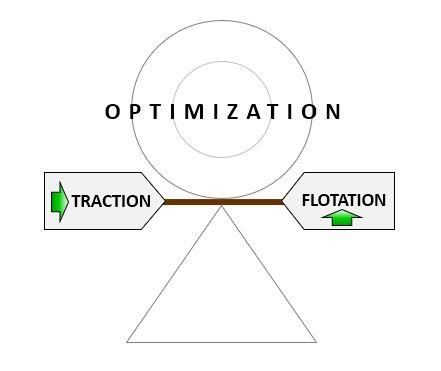Precision Inflation, LLC
Ken Brodbeck, VP of Technology
Can you have great traction and flotation? YES! Let us start with a couple definitions:
Traction: The ability to generate forces in the field and transport.
– to move the machine forward (Pulling) and backward (Braking)
– to move the machine left or right (Steering.)
Flotation: The ability to keep the tire as close to the soil surface without sinking causing ruts, compaction and worst case, becoming stuck.
Tire Flat Plate Area: The area generated by the tire footprint (Measured around the outside edges of the tire lugs) at maximum load and pressure on a flat steel plate.
How to use Flat Plate Area to compare tires:
- Do use flat plate area to compare tires within the same brand when comparing different sizes or Standard versus IF or VF in the same size.
- Shy AWAY using flat plate to compare tire Brand X to Brand Y. Due to companies using different measurement techniques, the numbers are all slightly different.
Some will be bigger and some smaller, but they will carry the same load at the same psi. The psi required is the MOST important factor!
Maximizing Traction:
- Increase weight
- Taller and/or wider tires
- Adding duals or triples
- Choosing premium IF or VF tires
- Most importantly, set pressure to the minimum per the load/inflation table
Maximizing Flotation and minimizing compaction:
- Removing excessive ballast, ie. Cast or liquid weight and extra tanks on a tractor
- Taller and/or wider tires
- Adding duals or triples
- Choosing premium IF or VF tires
- Choosing a Tire Inflation system to set tires to the optimum low pressure for field and the optimum higher pressure for transport
Does tire pressure really make that much difference? The footprints below are on a sprayer and we only changed the pressure to show a VF vs. Standard tire footprint.
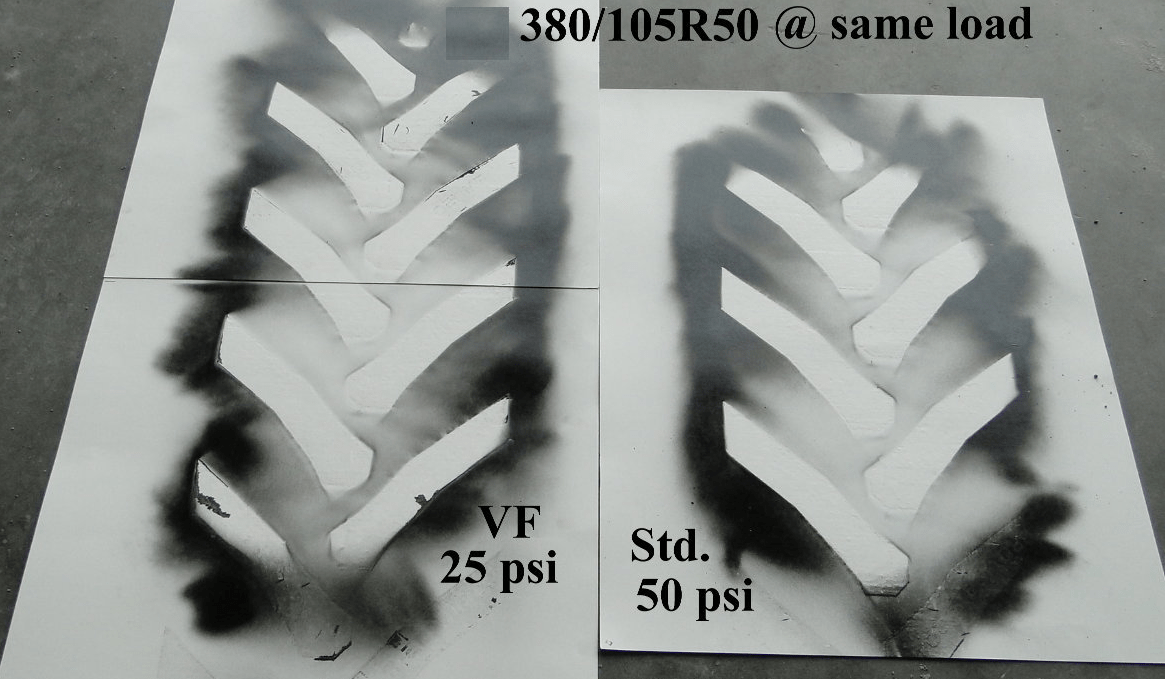
VF will provide great flotation at lower psi…………Std. tire will not float nearly as well at 50.
VF footprint will not wear as well on road………….Std. tire will wear best due to less squirm.
Bottom Line: You can have your cake and eat it too.
Just be sure to choose tires that can carry the tractor ballast between 8 to 14 psi with wheel slip in the 6 – 12% range. You will then have the most fuel efficient and lowest compaction tractor, even compared to a track machine.
Titan International, Inc. (Manufacturer of Titan and Goodyear Farm Tires)
Scott Sloan: Ag Product Manager / Global LSW
Traction by definition is the force that causes a moving thing to stick against the surface it is moving along. In the case of tractors, the ability to transmit the power of the tractor through the drive train and tires to the ground to do work such as pulling another piece of equipment.
Lack of traction can cause excessive tire to ground slip which equates to poor fuel efficiency and loss of productivity. This can be corrected in a number of different ways. The first being that the tractors total weight is properly ballasted to the amount of horsepower. Typically 100lbs to 120lbs per rated horsepower is the appropriate target. The correct weight will utilize the tractive efficiency of the tires in order to transmit the power properly to the ground. In addition, proper tire inflation based on the load will maximize the tires footprint on the ground to maximize the traction. To improve traction the amount of ground bearing pressure under the tire’s footprint needs to be maximized. It’s really pretty simple, a 250lb man with size 8 shoes has more traction than a 150lb man with size 8 shoes. The same can be said for tractors.
Floatation on the other hand by definition is the act, process, or state of floating or of causing or allowing something to float. In order to gain more floatation minimize the ground bearing pressures to increase the buoyancy or floatation of the machine. The heavier the machine the more ground contact area is needed to carry that load. Many growers remove ballast or for certain applications to minimize ground bearing pressures to minimize compaction issues usually during spring planting.
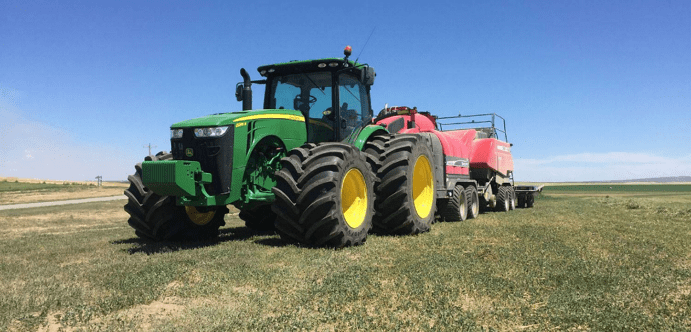
The trick comes with balancing the two, by definition and functionality in tractor applications they are the opposites. As you attempt to improve one you will inevitably be hurting the other. One methodology is to dual or even triple tires on equipment to increase the sq/in on the ground. However, as with any dual or triple configuration depending on the soil conditions it will result in rutting or loose soil being pinched and a berm will be created between the tires. The severity of that depends on how wet the soil actually is. Another downside is the overall width of the machine increases and creates a litany of new issues.
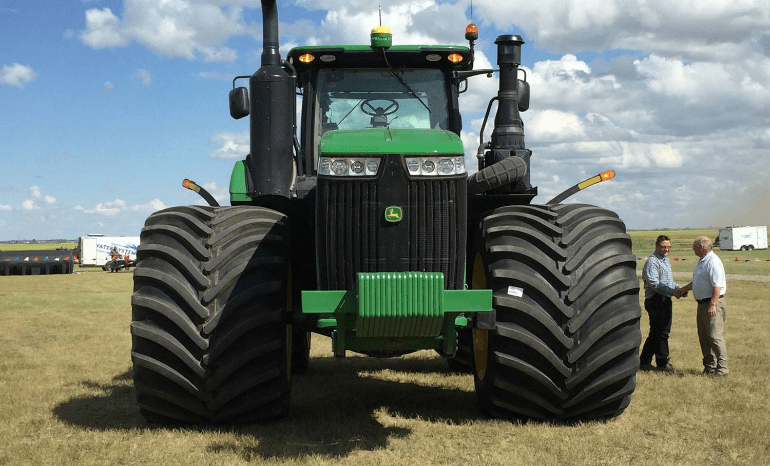 Another method which has been gaining popularity is to replace duals with super singles. One large tire in place of two. This immediately reduces the rutting in the field, and narrows up the machine making it easier to maneuver in tight areas. Larger super singles like and LSW1100/45R46 rear replacing dual 480/80R50’s and the LSW1000/40R32 replacing 380/85R38 nets in a 20% increase in flotation for a MFWD.
Another method which has been gaining popularity is to replace duals with super singles. One large tire in place of two. This immediately reduces the rutting in the field, and narrows up the machine making it easier to maneuver in tight areas. Larger super singles like and LSW1100/45R46 rear replacing dual 480/80R50’s and the LSW1000/40R32 replacing 380/85R38 nets in a 20% increase in flotation for a MFWD.
This configuration is a great balance for this type of machine. Traction improvements have been enjoyed while increasing the flotation of the machine
We have seen this same trend on 4WD machines. Large super singles like the LSW1400/30R46 have been replacing standard 800/70R38 duals. Even though the overall square inches on the ground are slightly reduced, the floatation characteristics are improved. Machines with the dual no matter the size will rut worse in fields which are saturated. In addition the overall width of the machine goes from 197” with the dual 800’s to 150” with the LSW1400’s. Again, this combination has proven time and time again on a properly ballasted machines that this is that perfect balance of traction and floatation.
Understanding the give and takes between traction and floatation and understanding the dynamics of each gives growers a chance to choose the best fitment for their machines.
Alliance Tire Americas
Nick Phillippi: National Product Manager
Traction and flotation can have a complicated relationship: sometimes they work together and other times they can work against each other. Understanding both can help farmers make appropriate tire choices.
From a tire engineering standpoint, traction, or tractive force, is the maximum amount of force that a tire can place against the surface for forward movement. It’s the measure of how much power the tire can deliver to the ground to move the vehicle forward without slipping. Once you’re slipping, your force is just moving the tire, not the machine.
Tire companies spend millions to design tires that can exert more force without slipping, using factors like tread and lug design, surface type, compounding and added featured like sipes or studs to increase the friction between a tire and the ground to increase its traction.
Flotation is the ability of an object, whether it’s a tire or a snowshoe, to remain on top of the surface. Another term for it is buoyancy. Overall footprint—the total number of square inches of tire in contact with the ground—is a good predictor of buoyancy. From the tire perspective, one might say that optimum flotation is the largest area of coverage to provide maximum traction while also exerting the least possible soil compaction pressure.
Optimum flotation is going to be very dependent on soil types and soil conditions.
If you’re in sloppy, thin mud, wide tires can provide plenty of flotation to keep you on the surface, but that slick soil will offer very little traction. You’d probably end up throwing a rooster tail of mud behind you while getting nowhere and wasting a lot of fuel. That’s exactly the situation we designed our R-2 tire to tackle—instead of providing flotation and keeping the tractor on the surface, it digs down to firmer soil and gets traction with extra-deep lugs. That’s what you need to get the job done in the kind of slick mud where rice and sugar cane are grown.
On the other hand, if you’re in heavy soils where a shallower lug can gain traction but you want to minimize soil compaction and rutting, you want more moderately sized lugs and a really large footprint from wide flotation tires or long VF tires.
Of course, in farming, you don’t get the same conditions every day. The problem is that many people select tires based on the most extreme conditions they may encounter rather than on more typical use scenarios. That can lead to inappropriate choices. For instance, an R-2 tire may be really helpful for a week or so in a particularly wet Midwestern spring, but it would wear too quickly, ride rough and tear up your fields most of the year.
In recent years, we’ve been developing unique, new treads that allow farmers to really fine-tune their tire choices. In the hills of eastern Washington, our block tread Alliance 550 MultiUse radials have become extremely popular on self-leveling combines that run on steep, silty slopes because they aren’t prone to side-slipping. In forage crops, manure haulers look for the curved shoulders and massive block treads of our 393 and 398 high-speed flotation tires to prevent rutting and minimize compaction. And we’re just about to redefine what an R-1 lug looks like.
The bottom line is that you have to think about the conditions you operate in over the course of a whole year. Do you want a rounded contact patch for digging into the soil—which is characteristic of a bias-ply tire—or the flatter, broader contact patch that you see with steel-belted radials? Think about what gets you through your soils, how much slip you can tolerate, how much compaction your soils can take, and what your tolerance is to the cost of fuel, tires and maintenance.
Just remember that flat plate—the square inches of your footprint and the number of lugs on the ground—is an important piece of data, but it’s not the only factor in choosing a tire.
Here are some tips to optimize your tire choice on a drive axle:
- Match your tire size and load index rating to the tractor weight and horsepower in the most common use.
- Choose the tread design that matches your soil and, in some cases, your application-specific need.
- Inflate your tires to the optimal air pressure for the most challenging loads and speeds at which you’ll be operating. It’s not convenient, but changing from higher pressure on the road to lower pressure in the field will provide the best performance in both conditions, maximizing safety and comfort and minimizing fuel consumption, wear and soil compaction. (This is why central tire inflation systems (CTIS) can improve tire performance so dramatically and pay off so quickly.)
- Don’t assume that buying the lowest cost tire is the best financial decision for your business. In many cases, premium tires provide benefits that will save you time, reduce fuel costs, decrease down time, increase productivity and cause less soil compaction. Those tires can often pay for themselves in a single season, depending on the size of your farm.
For free-rolling applications where forward traction is less relevant, the math changes a bit, but in most cases lateral traction and flotation (buoyancy) have high value to reduce drag—which costs wasted fuel—and minimize soil compaction.
Tire Pressure Matters
In the photos below, you can see the same tire inflated for roading (the 27 psi examples, with both “Planter Up” and “Planter Down”) and fieldwork (“Planter Down, 10 psi”). Look at the difference in footprint when the tire is set to pull the planter at road pressure—the center photo—vs. when its inflation pressure is set for fieldwork in the right-hand picture. You’ll see how many more lugs are in contact with the soil at 10 psi, and how much larger the footprint is. If you’re in pretty firm soil and you’re looking for traction and more flotation, this picture should speak a thousand words. (It should also make you consider investing in CTIS along with a great set of tires.)
As you can see, the proper pressure can have a dramatic impact on the footprint length, and, in the case of bias tires, even its width. Radial tires—especially steel belted ones—maintain a more constant footprint width.

Tire companies may disagree on a lot of things, but there is one topic on which even the bitterest of rivals will agree: inflating your tires to the proper pressure for the load and speed they’re operating under is by far the most important thing that you can do to maximize your traction, optimize your flotation, and to get the best performance out of your tire.
Continental Agriculture North America
Harm-Hendrik Lange: Agriculture Tires Field Engineer
In farming applications, traction and flotation tires have different operational tasks, although they are partly used together in many cases. The best example is a large slurry tanker being pulled by a large tractor on a field. We can compare both tire types in this exemplary application. What both tire types have in common is that they should carry the highest possible load with the lowest possible inflation pressure.
We already know:
Low Inflation Pressure => Larger Footprint => Less Soil Compression and Lower Track Depth
This means the lower the track depth, the less soil volume needs to be removed and deformed. So low inflation pressure means lower fuel consumption for both tire types, as well as less soil destruction and compression. It’s more efficient to deform the tire shape, than to deform the soil.
What´s the main difference between the traction and flotation tire applications?
For creating traction, and to have the maximum footprint possible, it’s often required to have the maximum number of lugs connected with the ground. But sometimes, maximum traction requires getting through a small layer of wet mud or loose surface material to get the grip of the more solid soil layers below. This means a little increased tire pressure can, in certain cases, even increase the traction potential, but this always depends on the actual situation of the ground.
In contrast to the traction tire, the flotation tire in implement application does not need to create so much grip, except by some brake force or side force transfer in hilly field operations. The main task of the flotation tire is:
- Reduced rolling resistance for low pulling force at high loads, especially on deformable surfaces, like dry sand or wet (clay) soils
- As the soil destruction potential of the complete vehicle combination (tractor plus trailer/implement) is generated by the tire with the highest inflation pressure, the air pressure in the flotation tires (implement or trailer tires) should not be much higher than the inflation pressure of the tractor tires
- While a driven tire actively works against the “bulldozing effect” by rotating, a non-driven tire needs to be turned by outer forces. With deeper track depth and small tires, the “bulldozing effect” becomes more and more significant as the tire is pulled against the soil wave (picture below). This means small tires with higher inflation pressure waste much more energy to fight against the soil wave in front of the tire.

As the space on the vehicle/trailer is defined, the maximum diameter of the tires is limited. This requires the flotation tires to compensate the required air volume for load capacity by maximum width and maximum sidewall height.
Tests performed by Prof. Dr. Ludwig Volk of the University of Soest showed on a 4-axle slurry tanker that the pull power demand can be reduced from 208 hp down to 147 hp by reducing the inflation pressure of the flotation tires from 58 psi to 14.5 psi on the field. The main driver for this efficiency effect is the difference in track depth, which was reduced from 5.9 inches at 58 psi down to 3.15 inches at 14.5 psi.
Flotation tires should show comparable sidewall flexibility like a tractor traction tire to give them the ability to operate with low inflation pressures. In contrast to that, truck tires which are still often used for agricultural trailers, don´t have this special side wall design for flexibility.
CEAT Specialty Tires Inc.
Jim Enyart: Technical Manager
Flotatation
Ag tire flotation is the ability to remain on or near the soil surface as you are moving across that surface. Flotation is directly related to the weight and the footprint of the tires that are carrying that weight. The larger the footprint the better the flotation as well as the lighter the weight the better the flotation. When you are increasing the footprint and/or reducing the weight carried you are reducing the weight per square inch or down pressure. Reducing the weight per unit area reduces the ground pressure and reduces the compaction potential. Reducing compaction potential results in maximizing crop production.
How do you maximize flotation? Reduce the weight carried and maximize the footprints of your tires. Reducing the weight carried isn’t usually much of an option but maximizing the footprint is a very good tool that will reduce compaction.
Tire selection is really key to maximizing the footprint. Adding more tires, wider tires, the larger diameter tires, higher load carrying capacity tires, higher aspect ratio tires, ‘”IF” or increased flexion tires and “VF” or very high flexion tires can help achieve your goal. Adding more tires like front duals along with rear duals, triples or even quads can make a big difference.
The air chamber of your tires determines the weight carrying capacity for the most part so increasing the air chamber will increase your flotation. The larger the air chamber the more you can reduce your air pressures which are directly related to ground pressure. You can increase the size of your air chamber by increasing the width, height and aspect ratio. The higher the tires’ load carrying capacity the more you can reduce your inflation pressures. The higher the aspect ratio the more sidewall you have available for sidewall deflection to grow your footprint. The “IF” and “VF” tires carry about 20% and 40% more load respectively at the same air pressures or carry the same load at the respectively reduced air pressures.
The way to maximize your flotation is easy. Add more tire! Utilize very large diameter tires with large section widths, high aspect ratios, high load carrying capacities, coupled with the “VF” technology. The theory is solid, but implementation can be challenging without full understanding.
Traction
Ag tire traction is the transfer of power to the ground resulting in movement across the surface. To maximize traction you need to reduce tire slip.
Reducing tire slip can often be achieved by increasing ballast weight- opposite to the concept of reducing pressure to the soil via flotation. In most soil conditions; however, utilizing the higher load carrying capacity tires as well as the “IF” and “VF” tires will also increase your traction as the footprint architecture is altered in length and provides more in line tractive surfaces- while simultaneously improving flotation.
Flat Plate
There are really no industry standards for comparing footprints so be careful when using this information to compare between manufacturers. In general, using the flat plate or footprint calculations as a tool to increase flotation is quite easy. The larger the footprint the better the flotation. Utilizing the footprint to increase traction is not so clear cut. In some cases, the smaller the footprint the better the traction because you simply increase your weight per inch or per unit area.
In Sum
The biggest problem is wanting to maximize our traction to maximize our efficiency while minimizing compaction potential to keep from reducing crop yields. Flotation and traction are almost on a teetertotter. As flotation increases the traction decreases due to reduced ground pressures. As the flotation decreases the traction increases. These opposing effects are not so dramatic under low torque applications but can be quite extreme in high torque situations.
The best way to increase traction while minimizing compaction during high torque applications is to make sure correct air pressures are used for road and field speeds, increase the footprints in length via “IF”, “VF”, use higher load carrying capacity tires, along with higher aspect ratio tires with larger air chambers- this will grow your footprint in length providing optimum flotation, while at the same time lining up your tractive surfaces to provide the most efficient transfer of power to the ground!
GRI Tires
Rick Harris: Regional Sales Manager
Flotation is the tire’s ability to reduce the impact on field conditions, like soil compaction.
Traction is a tire’s capability of accomplishing work with fewer resources such as fuel, labor, time and mechanical wear and tear.
GRI XLR series works to increase traction with self-cleaning mud breakers, deeper than standard R-1W tread depth, and optimized carcass construction.
Radial tire technology increases traction and flotation simultaneously much like a drag slick at the start line; the tire’s sidewalls absorb the engine’s torque allowing the tread to remain in full contact with the ground and produce optimal traction.
The flat plate allows consumers to evaluate the contact patch of the tread at recommended inflation pressures. A larger tread contact patch promotes increased traction and flotation. A greater surface area reduces the amount of equipment and cargo weight supported by each section of the contact patch increasing flotation and mitigating soil compaction.
BKT USA, Inc.
Dave Paulk: Manager Field Technical Services
Modern tractors are designed to transmit power from the engine to the ground. Transmitting that power requires moving traction to the soil surface. Traction determines how efficient this power is used. When the engine delivers too much power to the tires and friction to the soil is minimized, the tires will spin. Most modern medium to high horsepower tractors need weight added (ballast) to minimize wheel slip and maximize traction. The correct amount of ballast should be used to deliver enough traction for the power transmitted by the tractor without excessive wheel slippage. The needed weight is determined by the type of implements being used. Tractors can be weighted by cast weights or liquid in tires. Traction is created by correctly utilizing the power of the tractor and the weight of the tractor to pull the required implements. Traction can be limited by wheel slip and rolling resistance. Traction can be increased by increasing weight and tire size or reducing air pressure.
Traction can be affected by air pressure, flotation, and the contact area with the soil. A greater contact area and less inflation pressure will generally increase traction. Traction is greatly enhanced by using the right size of tire for the tractor, the correct ballast for the tractor predicated on the implements used, and correct air pressures for the weight of the tractor. This also reduces soil compaction and saves money on fuel and time.
Flotation tires are designed to deliver maximum traction while minimizing soil compaction. They have wider footprints to distribute the weight of the tractor, combine, cart, or implement over a wider area of soil. Flotation tires can roll over loose or wet soil and minimize soil damage by not creating deep ruts. They can be used in free rolling or drive wheel applications and can carry a large amount of weight. IF, VF, and IF-CFO/CHO technology has contributed to the versatility of flotation tires and allows them to be used in a variety of applications. Flotation tires are generally used on grain carts and wagons, combines, manure spreaders, and mixers.
The flat plate measurement of a tire is the contact area of the tire to the soil in square inches. The greater the contact area (flat plate measurement) of a tire footprint, the better the weight is distributed over the soil. Distributing the weight over a larger area reduces soil compaction and can increase traction. Row crop applications are limited to wider flat plate measurements by row width. If row width is not a concern, as in tillage or minimum tillage applications, a larger flat plate works well for traction.
There are basically four ways to manage traction efficiency and soil compaction. By managing the footprint of the tire, a farmer can increase traction and lower fuel costs. Managing the power of the tractor ensures that the tractor is weighted correctly, and the horsepower is efficiently used. Managing the ballast ensures the horsepower of the tractor is moved to the ground where it has the greatest value and is most efficiently used. Managing tire inflation pressure is using the right amount of air for the weight of the tractors and implements being used. Under inflation destroys tires. Over inflation can cause wheel spin and lost traction. It can also damage tires. Used with ballast, this is probably the largest contributor to maximum traction.
All these mentioned items work hand in hand to make a tractor (and equipment) efficient and deliver a good return on investment, with BKT producing a full range of farm tires and flotation tires to fit the needs of the modern farmer.
Michelin Ag
David Graden: Operational Market Manager – Agriculture
Traction and flotation are, and continue to be, confusing topics for many producers. In fact, with the addition of soil compaction, these topics are commonly the top three marketing and sales approaches for tier one Ag tire manufacturers today. At Michelin, however, solutions to these topics truly are our forte.
In sloppy soil conditions, there can be such a thing as too much flotation and not enough traction. On the other end of the spectrum, you can have too much traction and not enough flotation, which then gets into a situation resulting in major soil compaction. With the right tire, however, the chances of running into this can be slim to none. In fact, all Michelin Agriculture reps carry a set of scales and are equipped to handle the task of optimizing your machinery performance at any time.
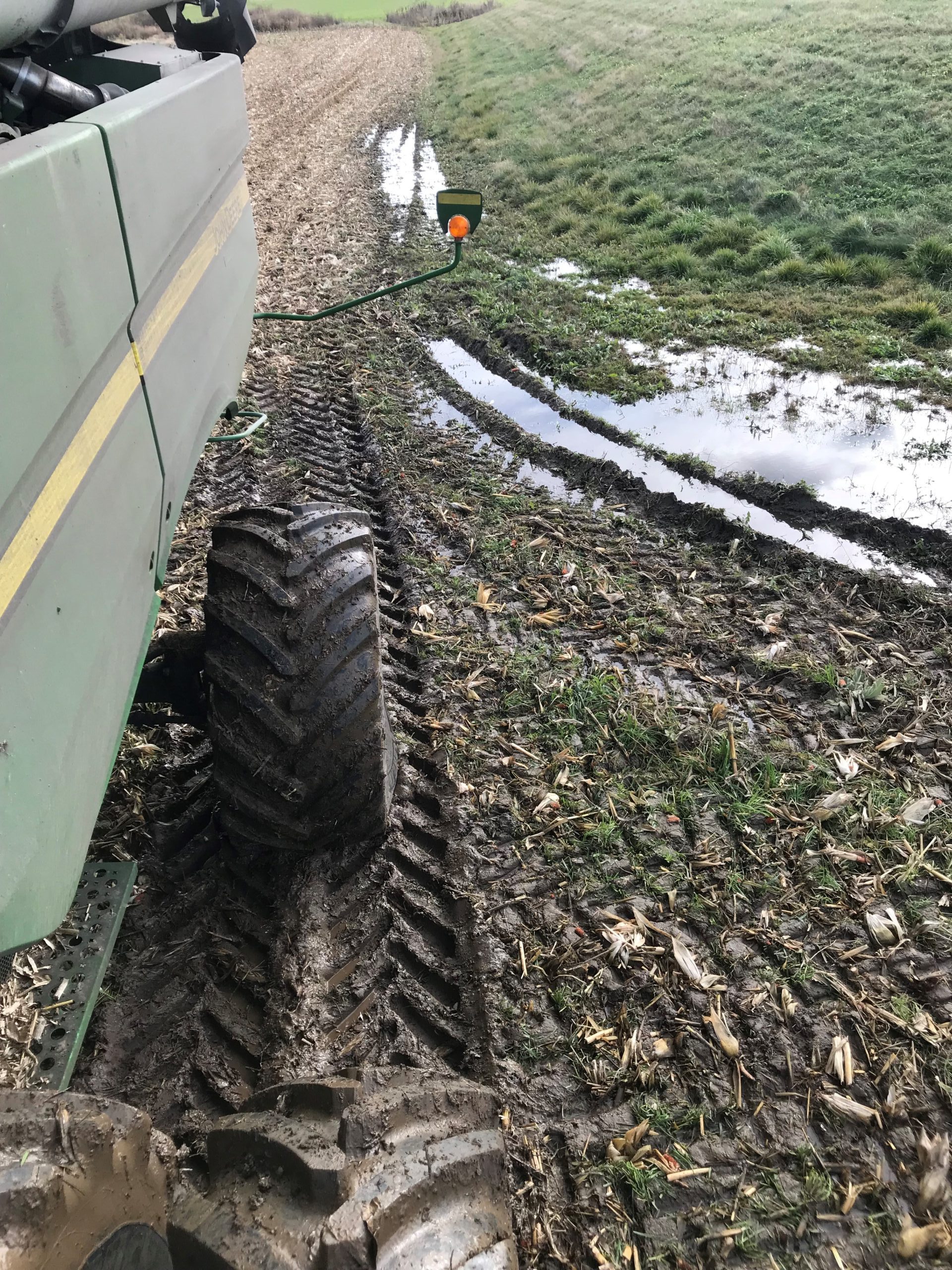 To achieve the best of both traction and flotation, I would recommend a Michelin IF or VF tire, with our standard R1W lug, at the proper recommended air pressure. If your machine weight distribution and air pressures are set properly, there is little that can stand in your way of getting the job done. As an example, the image to the left here shows an S series combine outfitted with Michelin VF Cerexbib tires, working in sloppy wet conditions. The operator of this machine was so amazed with the performance he stopped his machine, took this picture and called his local Michelin Ag tire dealer to discuss.
To achieve the best of both traction and flotation, I would recommend a Michelin IF or VF tire, with our standard R1W lug, at the proper recommended air pressure. If your machine weight distribution and air pressures are set properly, there is little that can stand in your way of getting the job done. As an example, the image to the left here shows an S series combine outfitted with Michelin VF Cerexbib tires, working in sloppy wet conditions. The operator of this machine was so amazed with the performance he stopped his machine, took this picture and called his local Michelin Ag tire dealer to discuss.
To take it a step further, you could also use gross flat plate as a tool to determine which tire is best for you. Gross flat plate, or contact patch, is basically defined as the footprint a tire puts on the ground. Many manufacturers publish this information, however, Michelin does not. Unfortunately, gross flat plate is not governed by any office or institution and left up to the tire manufacturer to decide how that footprint is created. Therefore, this produces inaccurate results when comparing one brand of tire to another. At Michelin, we calculate gross flat plate differently between IF/VF tires and standard radial tires, for example.
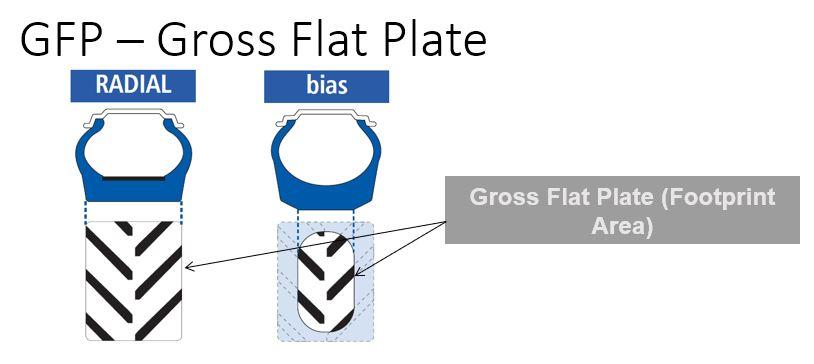
When measuring gross flat plat for standard radial tires, the footprint area is measured at maximum load and pressure for a 20 mph (30 km/h) application. When measuring gross flat plate for IF/VF tires, however, we calculate for the tires max speed schedule at max load and corresponding air pressure.
Something else to keep in mind is that gross flat plate is not linear, which means the measurement at max load and pressure will not be the same at operating conditions. Additionally, Michelin calculates sidewall deflection. As you go down in pressure and load, so the increase in gross flat plat is exponential. Depending on the size and volume of the tire, the growth from max load and pressure to least load and pressure could be up to 30+% difference.
Getting to the point, the only way for one to know, for sure, how different manufacturers gross flat plates compare is to create an impression on a hard surface with the two tires at the same air pressure and load, then measure and compare the actual footprints- Michelin reps can help with this.
In sum, achieving optimum traction and flotation is achieved by choosing the right tire for the application, maximizing footprint (lugs on the ground) with IF / VF technology, and using correct air pressure in accordance with weight / speed.
Maxam Tire International
Greg W. Gilland: Business Development & Ag Segment Manager
In any application that uses a pneumatic tire to act as the interface between the vehicle chassis and the ground, the key to successfully transmitting the force necessary to move in any direction is the application of the tire’s traction capability to deliver the torque or engine power, and the tire’s ability to float or carry the vehicle load at the necessary ground pressure to remain mobile.
Traction is the term used to explain how a tire overcomes the friction between the surface of the rubber tire and the ground. Friction is the resisting force that resists or acts against the relative motion of two surfaces. In other words, when a vehicle operates down the road, the vehicle engine generates the force or torque that push the vehicles wheels or tires forward and overcome the friction between the tire surface area and the road surface area. In summary, traction is the friction generated between the tire and the road or field surface.
Flotation is the ability of a tire to stay on the surface of soft ground, soil, or snow without rutting or digging into the surface or ground thus limiting the tire from overcoming the friction or providing traction. In agricultural applications, tires are designed to deliver the optimal traction or flotation based on their size, load capability and compounding. Ag tires are specifically sized to fit the wheelbase of vehicle chassis. Vehicle manufacturers choose the tire size that will provide their chassis design the optimal compromise between traction and flotation necessary for the tire to successfully overcome the surface friction to deliver the torque or mobility desired. In all cases, assuming the right tire size has been chosen, the key to delivering the best possible traction or force to overcome friction is the air pressure for a given load. When operating with a tractor in the field the coefficient of traction is measured by the “slip” of the tires as they roll through a field or road. Ag tires will use higher air pressure when operating on the road and lower air pressure when operating in the field. Here are some general rules that affect the ability of the tire to deliver traction:
If you work the field at the higher road inflation pressures:
- You will have higher tire slip.
- Tires will float less creating higher compaction.
- You will experience higher fuel consumption.
- Resulting in lower traction.
- Reduced work rate.
- Resulting in lower efficiency.
If you road the tractor at the lower field inflation pressures:
- You will have less slip but higher rolling resistance or tire friction
- You will have higher fuel consumption.
- Your will have higher tire wear rate.
- The tires will provide less ride comfort.
- The tire will have less or lower lateral stability.
- Resulting in lower efficiency.
In all cases, the optimum air pressure adjusted for the weight or load, and field condition (roading vs field work) will ensure that the tire delivers the best possible traction and flotation.
An Ag tire’s optimal air pressure also dictates how the tire construction or tread will provide improved or reduced flotation by extending or reducing the length of the tire footprint as provided below:
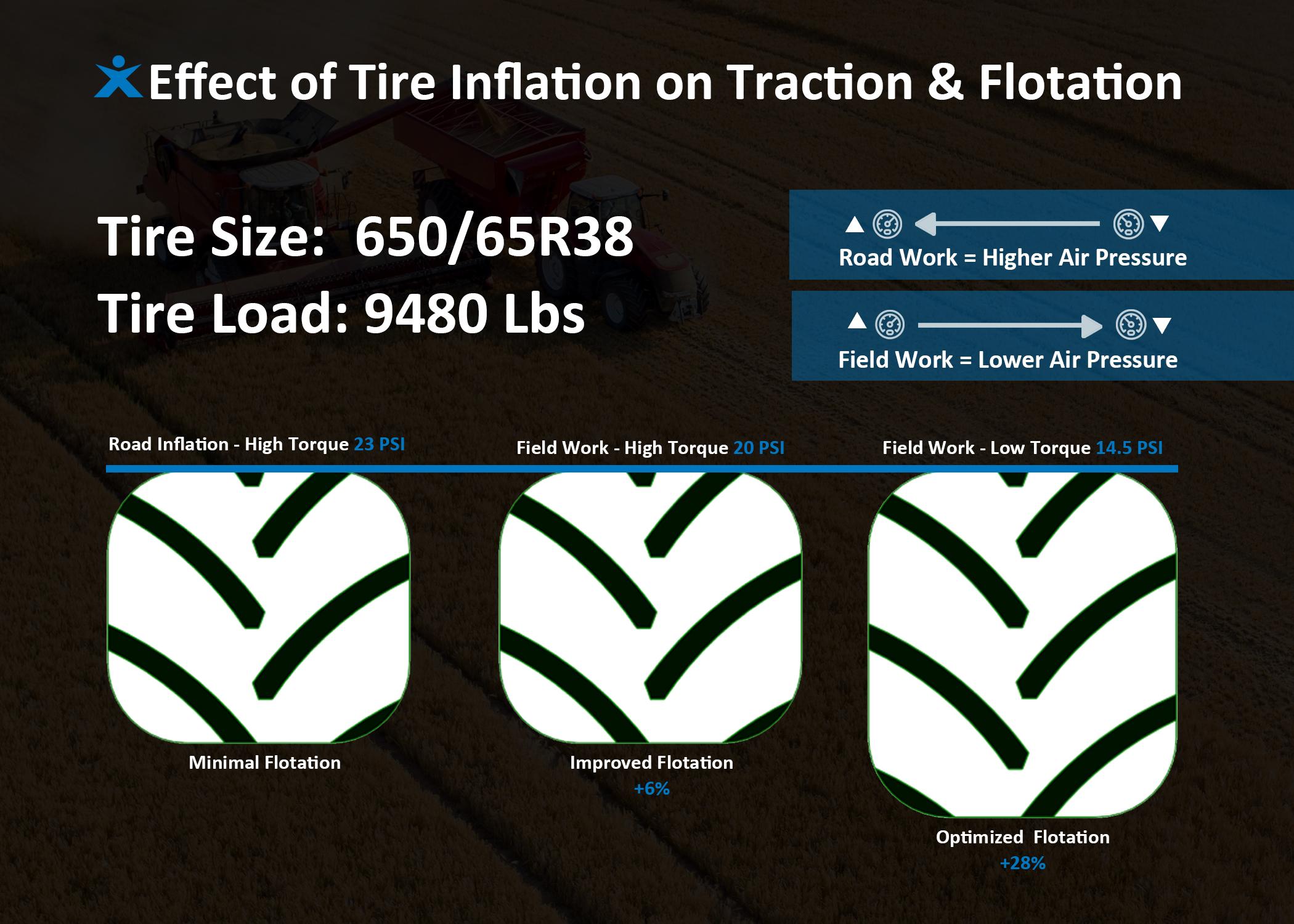
Tire traction is always improved when using the right air pressure for a given application. The vehicles slip meter will help the operator or grower determine the best possible air solution for their tires:
If tire slip is too high:
- Check that tire inflations may be high.
- Verify the load distribution from front to rear.
- Add tire ballast or weights as required.
- Optimize or adjust the working depth of any towed implement
If tire slip is too low:
- Check that tire inflations may be too low.
- Verify the load distribution from front to rear.
- Remove tire ballast or weights as required.
- Optimize or adjust the working depth of any towed implement
Trelleborg Wheel Systems
Norberto Herbener: OE Applications Engineer
Tires have been, and will continue be, the only link between farm equipment and the ground. Farmers and equipment manufacturers continually face the dilemma of how to increase equipment efficiency while minimizing damage to the soil structure.
As equipment keeps getting bigger and heavier, the greater the concern of how this affects crop development. As we know the heavier the equipment, the higher the soil compaction potential. The amount of soil compaction is directly related to how much pressure is exerted into the ground. Heavy loads, without properly distributing it, compacts the soil beneath. Higher compaction reduces soil porosity that restricts root development and oxygen availability for plant growth. The result is a smaller root system that explores less soil volume resulting in lower crop yields. Some weeds like velvetleaf, bindweed, quack grass, mustards and horse nettle flourish in these conditions.
We would all like to have zero compaction, but zero compaction means zero traction because the equipment would not be in contact with the soil.
It’s time to introduce a complete list of terms required to make this subject easier to explain:
- Footprint – this is the area that the tire contacts the ground. It is measured in square inches(in2).
- Tire Load – this is the amount of weight, in pounds, the tire is supporting.
- Ground Pressure – pressure is determined by dividing the tire load by the footprint. This is stated in lbs./in2. Higher ground pressure results in higher soil compaction.
- Flotation – is related to how much ground pressure is being applied by the tire. Tires with high flotation have lower ground pressures, and low flotation tires have higher ground pressures.
It’s a given that with a larger tire footprint, the ground pressure will be less, and compaction will be reduced (flotation). Looking at this situation, the clear answer is to reduce soil compaction by putting the largest total footprint possible on the soil by using larger tires, taller tires, and/or more tires. But where is the catch if the solution is that simple?
There is an inverse relation between flotation and traction, (i.e. higher the flotation the lower the traction, and vice versa). So, there must always be a compromise when trying to maximize flotation and reduce ground pressure, and still be efficient in transmitting the power to the ground. Inefficient power transmission (traction) from the tractor to the ground means increased slippage, increase fuel consumption and more time spent. Excessive slippage accelerates the rate of tire wear and can also contribute to soil compaction.
Let’s start on how we can assure efficient power transmission. There are some ground rules to follow that each equipment manufacturer promotes. Depending on the piece of equipment we are working with, there is an optimal weight to horsepower ratio. For example, a tractor pulling a heavy tillage implement would require between 100-120 lbs. of tractor weight per engine horsepower (a 400 hp tractor would need 40,000-48,000 lbs. of total weight). The second step is to define the correct front to rear axles weight distribution, that not only depends on the tractor configuration (front assist or 4WD tractor) but also the effect of the implement pull on the drawbar. This transfers additional load to the rear axle. Once we have determined how much load is being carried by each axle, we can decide which size and number tires are required per axle to carry the load and allow efficient power transmission for the function of this tractor (tillage, planting, spraying etc.).
Simple right, we also need to take into consideration the restrictions the piece of equipment may already have on the size of tire that can be fitted. Restrictions on how big the outside diameter of the tire can be and the maximum tire width for proper clearances with the fender/chassis. The minimum rim diameter required to clear the axle, transmission and braking system.
At this point it is important to mention that the main tire component that carries most of the load is not part of the tire structure at all, but the air volume inside the tire. The taller the tire (higher ratio between width and sidewall height), or the wider the tire, the larger the air volume is inside the tire and the higher the load carrying capacity.
If we try installing tires with extreme flotation, we will lose the needed ground pressure for efficient power transmission, or traction, and will result in increased slippage that wastes fuel and time. So, the question is, what is the limit on the largest size tire I can use to maximize flotation and minimize soil compaction? The recommendation is to choose a size tire that:
- First, fits your equipment.
- Second, can carry the load, at a given air pressure, that is enough to carry the maximum load. To determine the carrying capacity of the tire, consult the tire manufacturer’s load/inflation data tables located in their technical manuals.
- Third, the tire size meets the requirements of the field operation, row width, topology, soil conditions, etc.
It is possible to install too large of tires as the ground pressure will not be high enough for the lugs to sink into the soil and create the grip.
Also, even if the tire load/inflation table allows for it, do not use a tire with air pressure below the 10 psi threshold. Air pressure below this level may not exert enough pressure between the tire and rim to keep it from slipping on the rim. Rim slippage increases the risk of damage to the tire when driving on uneven terrain (for example over a big rock) and each tire can lose a small amount of air as the tire flexes over time. There is not a large enough gain in footprint when reducing the inflation pressure below the 10 psi to offset the risks.
One parameter that manufactures use to evaluate tire performance and how it flexes is the Flat Plate. This value describes the area or footprint of the tire when its inflated to specified nominal inflation pressure load (following the Load Index LI of the tire). This number is useful when comparing tires sizes and/or technologies from the same manufacturer since they use same testing methodology. This published value represents only one situation (max inflation pressure at nominal load) and its difficult to extrapolate to each individual inflation pressure and load condition. Also, different manufacturers measure this parameter in different ways so comparing data between manufactures can be problematic.
All information is provided in this blog solely to provoke thought. All deductions made from information on this site must be confirmed by Certified Ag Tire Dealer before use. Ag Tire Talk does not recommend anyone conduct tire service work with exception of Certified Ag Tire Dealer Professionals.

